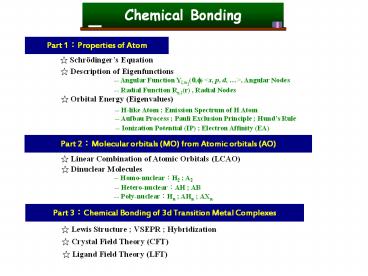Part 1:Properties of Atom - PowerPoint PPT Presentation
Title:
Part 1:Properties of Atom
Description:
Chemical Bonding Part 1 Properties of Atom Schr dinger s Equation Description of Eigenfunctions-- Angular Function Yl,ml( , ) , Angular Nodes – PowerPoint PPT presentation
Number of Views:49
Avg rating:3.0/5.0
Title: Part 1:Properties of Atom
1
Part 1Properties of Atom
? Schrödingers Equation
? Description of Eigenfunctions
-- Angular Function Yl,ml(?,?) lts, p, d, gt,
Angular Nodes
-- Radial Function Rn,l(r) , Radial Nodes
? Orbital Energy (Eigenvalues)
-- H-like Atom Emission Spectrum of H Atom
-- Aufbau Process Pauli Exclusion Principle
Hunds Rule
-- Ionization Potential (IP) Electron Affinity
(EA)
Part 2Molecular orbitals (MO) from Atomic
orbitals (AO)
? Linear Combination of Atomic Orbitals (LCAO)
? Dinuclear Molecules
-- Homo-nuclearH2 A2
-- Hetero-nuclearAH AB
-- Poly-nuclearHn AHn AXn
Part 3Chemical Bonding of 3d Transition Metal
Complexes
? Lewis Structure VSEPR Hybridization
? Crystal Field Theory (CFT)
? Ligand Field Theory (LFT)
2
Properties of Atom
? Schrödingers Equation
H? ? E?
HHamiltonian (H?K.E.?P.E.) ?Eigenfunctions EEig
envalues (Total Energy)
3
? Description of the Eigenfunctions
x ? r sin? cos? r ? 0, ? y ? r sin? sin?
? ? 0, ? z ? r cos? ? ? 0, 2?
Analytical Form
Quantum Numbers nPrincipal lAngular
Momentum mlMagnetic
?n,l,m(r, ?, ?) ? Rn,l(r)Yl,ml(?, ?)
4
Angular Functions, Yl,ml(?,?)
? The s function (l ? 0, ml ? 0)
Symbols Angular Nodes ? l ? 0
Angular ? Y0,0(?, ?) ? 1 Spherical shape
5
ml ? 0
? The p function (l ? 1, ml ? ?1, 0, ?1)
Symbolp Angular Nodes ? l ? 1
xy plane
pzYl,ml(?, ?) ? cos?
Y1,0(?, ?) ? 0 when ? ? 90? i.e. xy plane
ml ? ?1
pxYl,ml(?, ?) ? sin? cos?
pyYl,ml(?, ?) ? sin? sin?
Yl,ml(?, ?) ? 0
Yl,ml(?, ?) ? 0
? ? 0?, ? ? 0?
? ? 0?, ? ? 90?
yz plane
xz plane
6
? The d function (l ? 2, ml ? ?2, ?1, 0, ?1, ?2)
ml ? 0
Symbold Angular Nodes ? l ? 2
Yl,ml(?, ?) ? 3cos2? ? 1
when
ml ? ?2
ml ? ?1
Yl,ml(?, ?) ? sin2? cos2?
Yl,ml(?, ?) ? sin2? sin2?
Yl,ml(?, ?) ? sin? cos? sin?
Yl,ml(?, ?) ? sin? cos? cos?
Y 0 when ? ? 0?, ? ? ?45?
? ? 0?, ? ? 0? or 90?
? ? 0? or 90?, ? ? 0?
? ? 0? or 90?, ? ? 90?
7
Radial Functions, Rn,l(r)
Radial Nodes ? n ? l ? 1 Total Nodes ? n ? 1
Combine angular and radial nodes
8
Nomenclature for the Eigenfunctions, ?i
The Principal Quantum Number n The Angular Quantum Number l The Magnetic Quantum Number Ml
n ? 1, 2, 3, 0 ? l ? n ?l ? ml ? ?l
n ? 1 l ? 0 ml ? 0 1s
n ? 2 l ? 0 ml ? 0 2s
n ? 2 l ? 1 ml ? ?1 ml ? 0 ml ? ?1 2p?1 2p0 2p?1
n ? 3 l ? 0 ml ? 0 3s
n ? 3 l ? 1 ml ? ?1 ml ? 0 ml ? ?1 3p?1 3p0 3p?1
n ? 3 l ? 2 ml ? ?2 ml ? ?1 ml ? 0 ml ? ?1 ml ? ?2 3d?2 3d?1 3d0 3d?1 3d?2
9
? Orbital Energy (Eigenvalues)
For H En - Ry / n2
Degeneracy n2 e.g. 2s
2px,2py,2pz Degenerate states different
orbitals. Have same eigenvalue
Hydrogen-like Atoms
He? (Z ? 2), Li2? (Z ? 3), and Be3? (Z ? 4)
Slaters Rules for The Calculation of The
Screening Constant
n ? n ? 1 n ? n ? 1 n ? n n ? n
1s ? ? 0.30 0
ns, np 1 0.85 0.35 0
nd, nf 1 ? 0.35 0
10
Emission Spectrum of H Atom
E1 ? ?Ry (n ? 1) ground state
E2 ? ?Ry/4 (n ? 2) first excited state
E3 ? ?Ry/9 (n ? 3) second excited state
etc.
11
The Aufbau Process Klechkowskys Rule
1s ? 2s ? 2p ? 3s ? 3p ? 4s ? 3d ? 4p
n ? l 1 2 3 3 4 4 5 5
n / l 0 1 2 3
1 1s
2 2s 2p
3 3s 3p 3d
4 4s 4p 4d 4f
5 5s 5p 5d 5f
6 6s 6p 6d
7 7s
12
Pauli Exclusion Principle
Hunds Rule
For degenerate states, the electron is filled in
with the same spin to set the maximum total spin
quantum S.
13
(No Transcript)
14
Ionization Potential (IP)
A ? A? ? e? ?H ? IP -orbital energy
Element I1 I2 I3 I4 I5 I6 I7
Na 495 4560
Mg 735 1445 7730
Al 580 1815 2740 11,600
Si 780 1575 3220 4350 16,100
P 1060 1890 2905 4950 6270 21,200
S 1005 2260 3375 4565 6950 8490 27,000
Cl 1255 2295 3850 5160 6560 9360 11,000
Ar 1527 2665 3945 5770 7230 8780 12,000
15
Electron Affinity (EA)
X(g) ? e? ? X?(g) ?H ? ?B.E.
Electron Affinities of the Halogens
Atom Electron Affinity (kJ/mol)
F ? 327.8
Cl ? 348.7
Br ? 324.5
I ? 295.2































